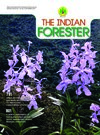Floristic Assessment of Panchlingeshwar Sacred Grove, Nandikurali, Raibag, Belagavi, Karnataka
DOI:
https://doi.org/10.36808/if/2018/v144i9/123006Keywords:
Sacred Groves, Nandikurali, Conservation, Belagavi.Abstract
The Sacred groves are forest patches conserved by the local people based on the socio-cultural and religious practices. The sacred groves are rich in diversity and play a significant role in the conservation of biodiversity. The present work was carried with the aim to document the floristic account and its assessment in the Panchlingeshwar sacred grove, Nandikurali, Raibag, Belagavi. A total of 171 taxa belonging to 145 genera distributed in 59 families were recorded, also the grove representing with 54 medicinal plant species belonging to 48 genera and 28 families.References
Airi S.R., Dharv R.S., and Parohit A.N. (2000).Assessment of availability and habitat preference of Jatamansi-a critically endangered medicinal plant of Western Himalaya. Curr. Sci., 79(10):1469.
Chandran M.D.S and Gadgil M. (1993). Sacred groves and sacred tree of Uttara Kannada capilot study Mimeograph. Centre for Ecological Science, Indian Institute of Science, Bangalore.
Curtis J.T. (1959). The vegetation of Wisconsin: An ordination of plant communities. University Wisconsin press. Madison, Wis, USA.
Curtis J.T. and McIntosh R.P. (1950). The interrelation of certain analytic synthetic phytosociological characters, Ecology, 31:443-445.
Gokhale Y., Velankar R., Subash Chandran M.D. and Gadgil M. (1998). Sacred woods, grasslands and waterbodies as selforganized systems of conservation, In: Conserving the Sacred for Biodiversity Management (Ramakrishnan, P.S., Saxena, K.G. and Chandrashekara, U.M., eds.) Oxford and IBH Publishing Co., New Delhi, pp.365-98.
Hasting J. (1934). Encyclopedia of religion and ethics. 12. 448-452.
Kalam M.A. (1996). Sacred Groves in Kodagu District of Karnataka (South India): A Socio Historical Study. Institute Francais de Pondichery, Pondichery.
Kambhar S.V. and Kotresha K. (2011). A study on alien flora of Gadag District, Karnataka, India, Phytotaxa, 16:52-62.
Khoshoo T.N. (1996). India needs a National Biodiversity Conservation Board. Curr. Sci., 71 (7): 506-513.
Khumbongmayum A.D., Khan M.L. and Tripathi R.S. (2004). Sacred groves of Manipur-ideal centres for biodiversity conservation. Curr. Sci., 87(4):430-433.
Malhotra K.C. (1998). Anthropological dimensions of sacred groves in India: an overview. In: Conserving the Sacred for Biodiversity Management, (Ramakrishnan, P.S., Saxena, K.G. and Chandrashekhara, U.M. eds.), Oxford and IBH Publishing Co., New Delhi, 423-438 pp,
Odum E.P. (1971). Fundamentals of ecology. Nataraj Publishers. Dehradun.
Panse V.G. and Sukhatme P.V. (1985).Statistical methods for agricultural workers. ICAR, New Delhi.
Pushpangadan P., Rajendraprasad M. and Krishnan R.N. (1998). Sacred groves of Kerala; a synthesis on the state of art of Knowledge, In: Conserving the sacred for Bio-diversity Mangement (Ramakrishnan, P.S., Saxena, K.G. and Chandrashekara, V.M. eds.), Oxford and IBH publishing Co., New Delhi, 193-210 pp.
Rao P., Barik S.K., Pandey H.N. and Tripathi R.S. (1990). Community composition and tree population structure in a subtropical broad-leaved forest along a disturbance gradient. Vegetation, 88:151-162.
Singh J.S., Raghubanshi A.S. and Varshney K. (1994). Integrated biodiversity research in India, Curr. Sci., 66(70):109.
Downloads
Downloads
Additional Files
Published
How to Cite
Issue
Section
License
Unless otherwise stated, copyright or similar rights in all materials presented on the site, including graphical images, are owned by Indian Forester.





